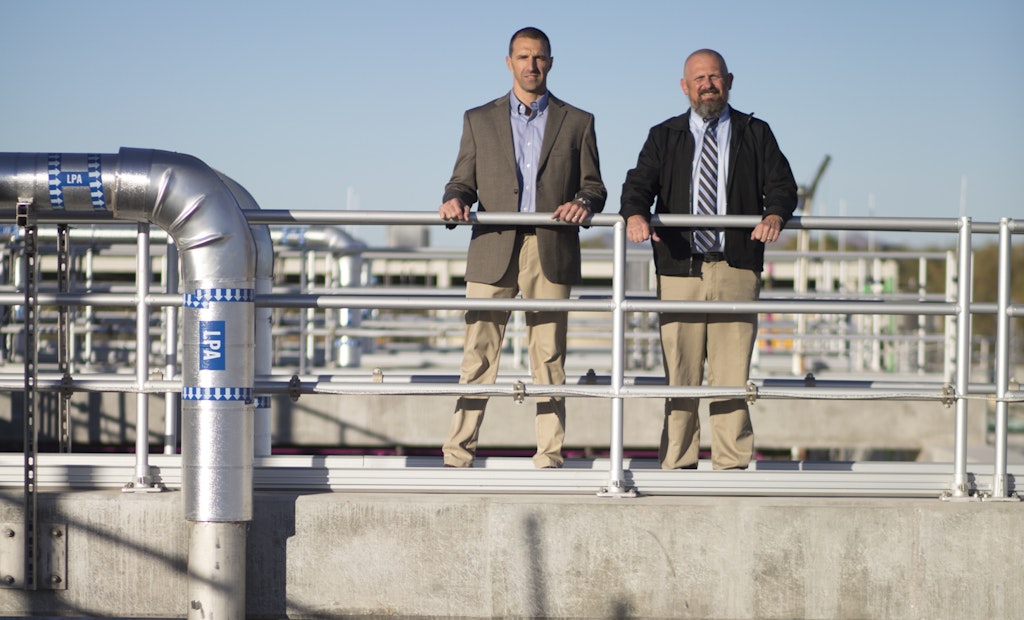
A portrait of Water Department Assistant Director Scott Schladweiler (left) and Director John Kmiec and at the Marana (Arizona) Wastewater Reclamation Facility. (Photo By Mark Henle)
The water management goal in Marana, Arizona, northwest of Tucson, is to use renewable water resources whenever and wherever possible.
The utility relies on Colorado River water through the Central Arizona Project (CAP), groundwater, and reclaimed wastewater to supply its 8,000 customers. It does everything possible to use water wisely in the face of drought and diminishing surface water supplies.
“It’s definitely a huge challenge,” says Water Department Director John Kmiec. “We have to transition to renewable water sources as soon as possible.”
In the case of Marana, that means smart management of its allotment of Colorado River water through the CAP.
“We can either use it the same year it is delivered, or bank it for long-term storage credits,” says Kmiec.
In one innovative approach, Marana Water contracts with a large agricultural operation so that the farm uses a portion of the CAP water assigned to the utility, while Marana obtains credit for the groundwater the farm would have pumped from the aquifer. “Over-pumping has led to disasters in the past,” says Kmiec. “This way we use all the CAP water allocated to us. It just works out better for us financially and is more environmentally sustainable.”
Wastewater reclamation
In addition, Marana has brought its new wastewater reclamation facility online and is getting credits for the treated water it is putting back into the aquifer. The plant features a four-stage Bardenpho process, followed by sand filtration and Trojan UV disinfection system. Design flow is 1.5 mgd, with current flow around 0.5 mgd.
The new facility is a Carollo Engineering design and the construction manager was PCL. (Arizona water credits reward utilities for banking groundwater for at least one year and allow these utilities to pump and use the water in the future.)
The utility aggressively promotes conservation and recently received an award for participating in a forward-looking multi-community project that will help reduce groundwater overdrafting across the region.
Award winner
Working with the nearby water departments of the Town of Oro Valley and the Metropolitan Domestic Improvement District, Marana Water recently took an important step to assure adequate groundwater supplies in the future. Rather than having the different municipalities pumping from different groundwater deposits, the agencies agreed to consolidate recharged groundwater in a central location, and provide each with the ability to pump to its service area as needed.
It’s a 50-year agreement called the Northwest Recharge, Recovery and Delivery System, and it won a Metropolitan Pima Alliance Common Ground Award for community collaboration.
Established in 1977
The Marana Water Department was established in 1997, and in 2017, it was recognized as the Small Water System of the Year by the AZ Water Association.
The town’s original population was around 1,500 in 1977, but now is closing in on close to 50,000 by 2020. The Marana Water Department serves about 50 percent of the current population with Tucson Water serving the rest. Most of all future growth in Marana will continue within the Marana Water Department service area.
The department supplies water to its customers through a series of groundwater wells, above-ground storage tanks and seven independent water distribution systems. About 2,400 acre feet of water per year are imported from the Colorado River through the CAP canal, which runs 336 miles from Lake Havasu in northwest Arizona to the Tucson area in the south.
At the wellheads, water is treated with calcium hypochlorite for disinfection before it is pumped to end-users.
The current infrastructure plan includes rehabilitating some of the older water lines in the community, maintaining the water storage tanks, and replacing the utility’s SCADA system. Interconnectivity among Marana’s seven different water systems is the long-term strategic goal. This will be done by a series of capital projects that will start to lay the distribution piping necessary to move water back and forth from systems that are currently operated independently.
Beer contest
Direct potable reuse (DPR) also figures in Arizona’s future water supply, and that’s what drove a recent project using reclaimed wastewater to make beer.
“It was a state-wide demonstration project,” says Kmiec. “It's called the AZ Pure Water Brew Challenge. Marana Water was part of the project team, along with Pima County Wastewater, Tucson Water, the University of Arizona, and CH2M and Carollo engineering firms.
They designed a direct potable reuse facility inside a semi-truck trailer. The cities of Flagstaff and Phoenix participated by allowing the treatment truck to treat water from their facilities to serve brewers in their area.
A total of 26 Arizona breweries accepted the challenge, and the brews were tapped at the WateReuse Association Symposium in Phoenix in late 2017.
Winner was Clear Water Pilsner from Dragoon Brewing Co. Pure Water Double IPA (Arizona Wilderness Brewing) and Tamarind Sour Brown (Crooked Tooth Brewing) also ranked among the favorites with the judging panel and the public.
Kmiec says the challenge demonstrated to the general public that direct potable reuse (DPR) was feasible and acceptable. “We showed that it could be done,” Kmiec says. “We had overwhelming support wherever we went. They may not have completely understood the process but we showed them how it could be done and gave them a product. Once they could see it and taste it, they believed.”





